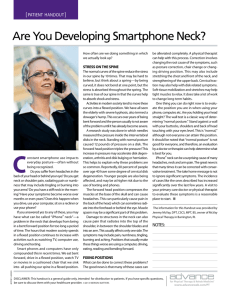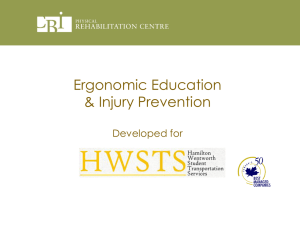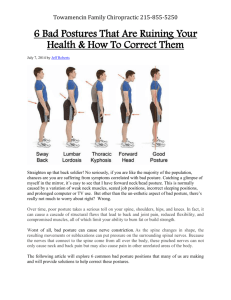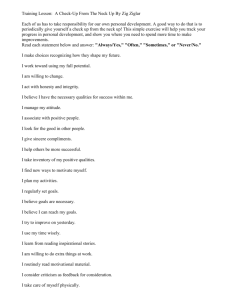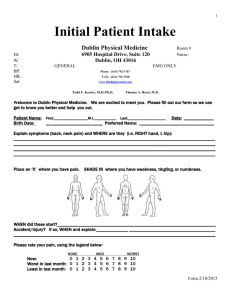seven keys to healthy neck posture
advertisement
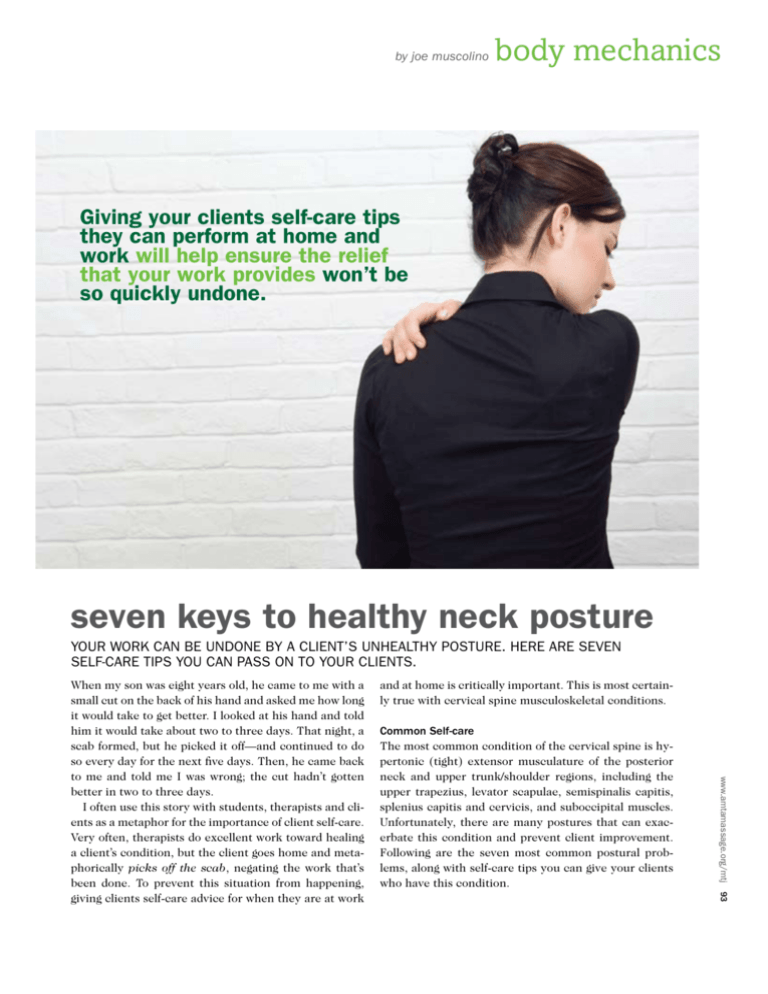
by joe muscolino body mechanics Giving your clients self-care tips they can perform at home and work will help ensure the relief that your work provides won’t be so quickly undone. seven keys to healthy neck posture Your work can be undone by a client’s unhealthy posture. Here are seven self-care tips you can pass on to your clients. and at home is critically important. This is most certainly true with cervical spine musculoskeletal conditions. Common Self-care The most common condition of the cervical spine is hypertonic (tight) extensor musculature of the posterior neck and upper trunk/shoulder regions, including the upper trapezius, levator scapulae, semispinalis capitis, splenius capitis and cervicis, and suboccipital muscles. Unfortunately, there are many postures that can exacerbate this condition and prevent client improvement. Following are the seven most common postural problems, along with self-care tips you can give your clients who have this condition. www.amtamassage.org/mtj 93 When my son was eight years old, he came to me with a small cut on the back of his hand and asked me how long it would take to get better. I looked at his hand and told him it would take about two to three days. That night, a scab formed, but he picked it off—and continued to do so every day for the next five days. Then, he came back to me and told me I was wrong; the cut hadn’t gotten better in two to three days. I often use this story with students, therapists and clients as a metaphor for the importance of client self-care. Very often, therapists do excellent work toward healing a client’s condition, but the client goes home and metaphorically picks off the scab, negating the work that’s been done. To prevent this situation from happening, giving clients self-care advice for when they are at work ILLUSTRATIONS © GIOVANNI RIMASTI Figure 1A: Flexing the neck and head to look at a PDA in the lap requires isometric contraction of neck extensor muscles to hold the head in an imbalanced posture. 1 no. 1B: Bringing the PDA up to eye level relieves the stress on the neck. Note: it’s important for the (upper) arm to be relaxed. flexed head/neck posture Many activities of daily life, whether they are at home or on the job, involve working down in front of our body. Examples include reading a book in our lap, working on a cell phone/PDA, writing or typing on a keyboard, and tending to a baby. The problem is that if we bring our head and neck into flexion to look down at what we are doing, the center of weight of our head is no longer balanced over our trunk. Instead, the weight is now hanging in thin air, imbalanced, and our chin would fall to our chest, bringing our neck all the way into flexion. To prevent this, our posterior neck extensor mus- culature isometrically contracts (Figure 1a). When we add up how many hours we are in this posture, it’s no wonder that we overuse and abuse these muscles! The key, whenever possible, is to bring what we are working on up to our eye level instead of flexing our head/neck down (Figure 1b). Note: The same concept is true when reading a book. Instead of reading with a book placed in our lap, we should place reading material at eye level, using a bookstand if the book is heavy. 2 no. forward carriage 94 mtj/massage therapy journal spring 2010 (protracted) posture of the head and neck. Figure 2A: A forward (protracted) head posture also imbalances the head over thin air, placing a stress on neck extensor muscles. 2B: Clients should be reminded to tuck their chin and bring their neck posteriorly over their trunk. Similar to a flexed neck posture, this condition involves flexion of the lower neck with extension of the upper neck and head. This posture also places the center of weight of our head anteriorly over thin air, resulting in prolonged isometric contraction of the posterior extensor musculature (Figure 2a). The key to lessening this posture is to remind our clients to tuck in their chin to flex the head, and extend their lower neck back over their trunk (Figure 2b). 3 no. body mechanics holding our arms in abduction to the side of our body, in flexion in front of us, or anywhere in between. Figure 3A: Holding the arm out to the side or front of the body to work with a computer mouse requires contraction of the upper trapezius as a stabilizer of the scapula. 3B: Working with the mouse closer to our body allows the (upper) arm to relax and hang vertically at the side of the body, relaxing the upper trapezius. Unfortunately, many postures involve holding our arms out in the air. The problem is that abduction and/or flexion of the arm at the glenohumeral joint requires scapular stabilization, usually accomplished by isometric contraction of the upper trapezius. Examples include working with a computer mouse or keyboard that is too far away (Figure 3a), or trying to hold a book or magazine up to our eye level when we are reading. To prevent this type of posture, it’s important to bring our work closer to our body so that our (upper) arm is relaxed and hanging vertically down by our side (Figure 3b). Figure 4A: Carrying a purse or bag on the same-side shoulder, regardless of its weight, requires contraction of scapular elevation muscles to prevent the bag from falling off. 4B: Carrying the bag across the body removes the need to contract muscles to elevate the shoulder girdle. carrying a purse or bag on our shoulder. Even if the bag is empty and very light, the natural slope of the shoulder means we’re going to have to elevate the scapula/shoulder girdle with contraction of the upper trapezius and levator scapulae to prevent the bag from sliding off (Figure 4a). This isometric contraction overuses and abuses these muscles of the neck. If the bag is heavy, it’s even worse because a more powerful muscular contraction is needed, and the strap of the bag digs into the musculature of our shoulder, causing direct physical irritation and cutting off local blood circulation. It’s better to either wear the bag across the body (Figure 4b) or to use a back-pack, fanny pack or clutch purse that is held in the hand. Even better is to use a bag that is transported on wheels. www.amtamassage.org/mtj 95 4 no. body mechanics 5 no. carrying a weight, especially a heavy weight, in our hand. Examples include carrying a computer bag, heavy purse, suitcase or other travel bag, or even a sack of groceries. Holding a weight of any kind in the hand creates a traction force on the upper extremity that pulls the shoulder girdle down toward the ground. This action must be countered by contraction of the upper trapezius, levator scapulae and rhomboids as muscles of scapular elevation (Figure 5). Preventive measures include transporting heavier weights in a bag with wheels or a backpack (especially one that distributes the weight to the hips). When this isn’t possible, it’s better to split the weight between the two hands to even the load. Figure 5: Carrying a weight in the hand, such as a computer bag, requires contraction of scapular elevation muscles to prevent the downward pull on the shoulder girdle by the weight. ILLUSTRATION COURTESY OF JOSEPH E. MUSCOLINO 96 mtj/massage therapy journal spring 2010 Figure 6A: Crimping a phone between the ear and shoulder requires isometric contraction of neck and shoulder girdle musculature. 6B: Holding the phone with the opposite-side hand allows these muscles to relax. 6 no. “crimping” a phone between the ear and shoulder. Crimping requires lateral flexion of the neck and elevation of the shoulder girdle (Figure 6a). Holding this posture requires isometric contraction of all muscles of the neck, but especially the upper trapezius and levator scapulae. An alternative to crimping the phone is to hold it with the opposite-side hand, which leaves one hand free if writing is necessary (Figure 6b). Even better, use a headset. 7 no. unhealthy sleep posture. Given that the average person sleeps between six and eight hours per night, we literally sleep between one quarter and one third of our life. An unhealthy sleep posture can greatly add to a client’s neck condition. If the client sleeps on their stomach, their neck is forced into a posture of neck rotation for the entire night. If the client sleeps on their back or side with a pillow that is too thick, their neck is forced into excessive flexion or lateral flexion respectively (Figure 7a and b). The healthiest sleep posture is either on the back with a small pillow that supports the normal lordotic curve of the neck, or on the side with a pillow that supports the head and neck in a neutral posture (Figure 7c and d). Note: The pillow shown in ‘c’ and ‘d’ is a “cervical pillow” that has a depression in the middle, allowing the head to rest down in a neutral anatomic position. Figure 7A and B: Sleeping on the back or side with a pillow that is too thick places the neck in an unhealthy posture. 7C and D: Using a thinner pillow allows the neck and head to remain in a healthy neutral posture. ing to your clients about these seven common postures that affect their neck. n Joseph E. Muscolino, DC, is an instructor at the Connecticut Center for Massage Therapy and Purchase College. He is the owner of The Art and Science of Kinesiology in Stamford, Connecticut, and the author of The Muscle and Bone Palpation Manual, The Muscular System Manual and Kinesiology, The Skeletal System and Muscle Function textbooks (Elsevier, 2009, 2010 and 2006). Visit Joseph’s website at www.learnmuscles.com. www.amtamassage.org/mtj 97 Looking over this long list of postures that can contribute to tight extensor musculature of the posterior neck and top of shoulder, it’s easy to see why these muscles are so often tight. Whether the client’s condition is mild or severe, if the client doesn’t remove the physical stresses that cause poor postures, the chances of healing and long-term relief are limited. We may possess the ideal treatment tools to help these clients, including massage, heat, stretching and joint mobilization, but if we do not involve the client in their own care with sound self-care advice, we will likely find that our results are temporary and limited at best. If you do not already do so, I recommend that you begin talk-

